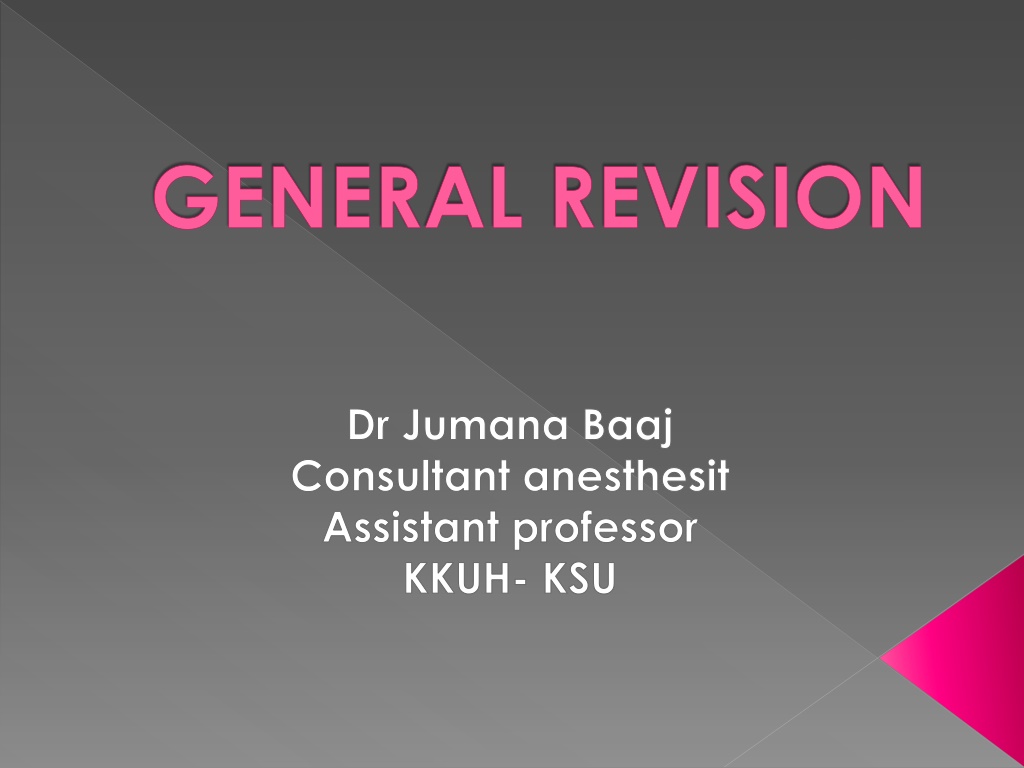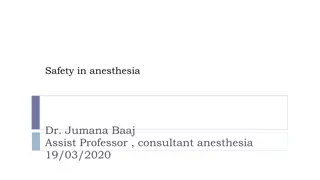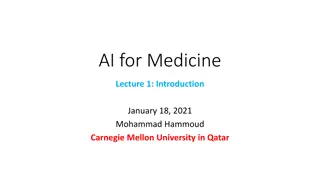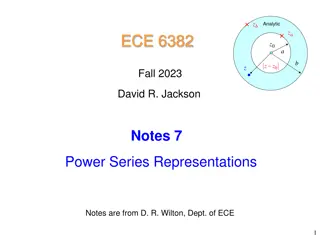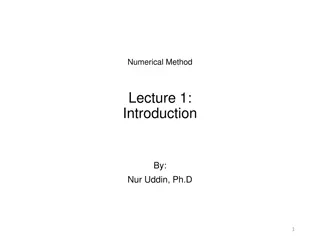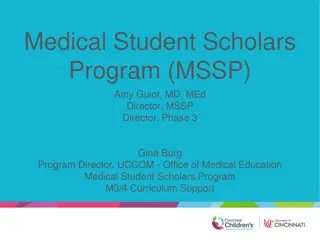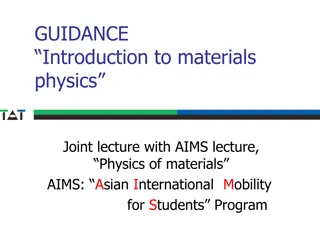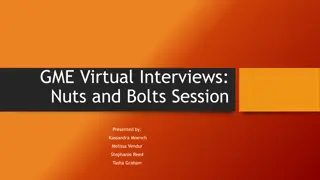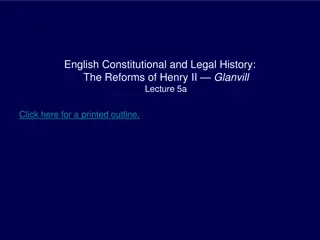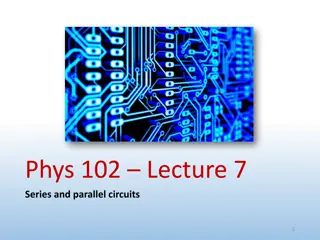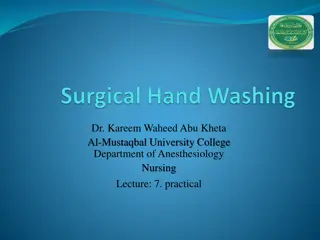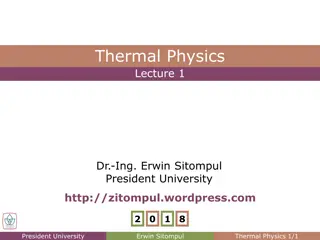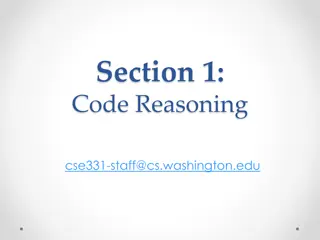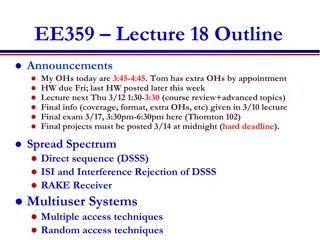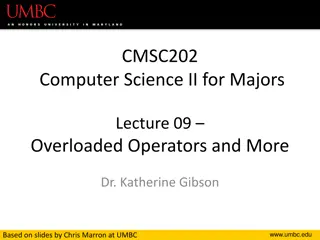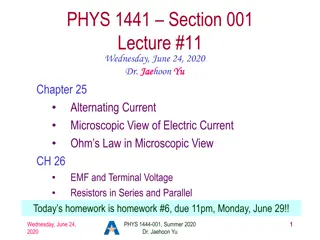Anesthesiology Lecture Series: Comprehensive Overview by Dr. Jumana Baaj
Delve into the realm of anesthesiology with Dr. Jumana Baaj's comprehensive lecture series covering the role of an anesthetist in preoperative care, NCEPOD classifications, perioperative patient journey, general anesthesia techniques, and airway management. Learn about patient assessment, anesthetic options, classification of interventions, surgical safety, discharge criteria, anesthesia induction agents, airway anatomy, ventilation, and monitoring strategies. Elevate your understanding in this vital field under expert guidance.
Download Presentation

Please find below an Image/Link to download the presentation.
The content on the website is provided AS IS for your information and personal use only. It may not be sold, licensed, or shared on other websites without obtaining consent from the author. Download presentation by click this link. If you encounter any issues during the download, it is possible that the publisher has removed the file from their server.
E N D
Presentation Transcript
GENERAL REVISION Dr Jumana Baaj Consultant anesthesit Assistant professor KKUH- KSU
Role of anaesthetist in the preoperative care Lecture a) Obtain a full history and physical examination including allergies, current medications, past anesthetic history, family anesthetic history b) Understand how patient co-morbidities can affect the anesthetic plan. c) Understand potential anesthetic options for a given surgical procedure. d) ASA CLASSIFICATION e) NCEPOD classification of intervention (National Confidential Enquiry into Patient Outcome and Death
NCEPOD classification of intervention (National Confidential Enquiry into Patient Outcome and Death Description Example Immediate Life/limb/organ saving Resuscitation occurs simultaneously with surgery Surgery within minutes Rapid bleeding, e.g. trauma, aneurysm Life/limb/organ threatening Surgery within hours Perforated bowel or less urgent bleeding Urgent Early surgery (within a day or two) Large bowel obstruction, closed long bone fracture Expedited elective Timing to suit patient and hospital Joint replacement, unobstructed
The perioperative patient journey Consent Surgical safety checklist Criteria for discharge from a day surgery unit
General anaesthesia technique a) Definition of general Anaesthesia b) Learn about several agents used on induction of general anaesthesia including intravenous agents, inhalation agents, neuromuscular blocking agents and reversal agents. c) Understand basic advantages and disadvantages of these agents. d) Complications commonly encountered during general anaesthesia
Airway Management and equipment a) Learn about basic airway anatomy b) Conduct a preoperative airway assessment c) Identify a potentially difficult airway d) Understand the issues around aspiration and its prevention e) Learn about the management of airway obstruction f) Become familiar with airway equipment g) Practice airway management skills including bag and mask ventilation, laryngeal mask insertion, endotracheal intubation h) Learn about controlled ventilation and become familiar with ventilatory parameters i) Appreciate the different ways of monitoring oxygenation and ventilation
Airway Management and equipment Airway assessment (malampati) Airway devices LMA sizes Airway manipulation
RegionalAnaesthesia Techniques a) What are the risks and benefits of regional (epidural/spinal) anesthesia/analgesia? b) What are the contraindications to regional anesthesia? c) How do you prevent hypotension following epidural/spinal anesthesia?
Spinal Anaesthesia a) Describe the technique of spinal anesthesia. b) At what level does the adult spinal cord end? c) Name some of the surgical procedures that can be done with a spinal anesthetic. d) What are the contraindications to spinal anesthesia? e) What are the complications? f) Describe the patient's perception as spinal anesthetic takes effect. g) What are the expected cardiovascular changes associated with sensory level at T10? T1? h) How do you treat post-lumbar puncture headache?
Epidural Anaesthesia a) Discuss the differences between spinal and epidural anesthesia. b) What are the advantages and disadvantages of epidural compared to spinal anesthesia? c) Study the size and tip of the epidural needle. d) Name some of the surgical procedures that can be done with an epidural anesthetic. e) What role does epidural has for post-operative pain control? f) Local Anesthetics Pharmacology and toxicity (Lidocaine, Bupivacaine
Intravenous Fluid Resuscitation and Blood Transfusion (2 hours) Fluid Requirements and Fluid Therapy a) What perioperative factors affect the patient s fluid requirements? b) How do you estimate maintenance fluid requirements? c) What are some common conditions associated with preoperative fluid deficits? d) List the potential physical and laboratory findings seen in a patient with a volume deficit. e) How do you calculate the patient s preoperative fluid deficits?
Intravenous Fluids Crystalloids What is the difference between normal saline, and Ringer's lactate? What are the advantages and disadvantages of crystalloids? Colloids What colloid preparations are available for clinical use? What are some advantages and potential side effects of hetastarch? When to use 5% or 25% albumin preparation in volume resuscitation? When is plasma indicated?
Blood Products a) What is the minimal acceptable hemoglobin? What factors affect the minimal acceptable hemoglobin level? b) How do you calculate the acceptable blood loss during surgery? c) What is the difference between autologous and banked blood? d) What are the routine screening tests of banked blood? e) What administration set do you use for red blood cell, plasma and platelet transfusion? f) How much increase in Hb level do you expect from transfusing one unit of RBCs? g) What side effects can occur with the transfusion of blood products? h) What are the side-effects (potential complications) of massive or rapid blood transfusion? i) What is the indication for the transfusion of fresh frozen plasma, cryoprecipitate, and platelets?
7- Monitoring During anaesthesia (2 hours) Monitors : a) non-invasive blood pressure b) ECG c) pulse oximetry capnography (CO2 monitor) and oxygen analyzer d) Temperature probe nerve stimulator Specialized monitors : a) arterial line (invasive blood pressure) b) central venous line (cvp monitoring) c) pulmonary artery flotation catheter ( monitors function of right and left side of the heart) d) BIS monitor (depth of anesthesia)
Vascular Access a) Examine the construction of the commonly used venous catheters. b) Anatomical considerations regarding peripheral and central venous access. c) Discuss the choice of catheter size. d) Prepare and set-up an IV infusion set. Why do you need a gas-fluid level in the drip chamber? e) Discuss the choice of sites for placement of IV catheters. f) What are the different sites suitable for central venous catheter placement? g) Discuss universal precautions. h) Indications and complications of central venous access
Postoperative management (2 a) Learn a common approach to emergency medical problems encountered in the postoperative period. b) Study post-operative respiratory and hemodynamic problems and understand how to manage these problems. c) Learn about the predisposing factors, differential diagnosis and management of PONV. d) Understand the causes and treatments of post-operative agitation and delirium. e) Learn about the causes of delayed emergence and know how to deal with this problem. f) Learn about different approaches of post-Operative pain management
Anesthesia Pharmacology Intravenous anesthetic agents Inhalational anesthetic agent Muscle relaxants Adjuvant to anesthesia drugs
Case senareo A 26 year old male patient is admitted to the emergency department diagnosed to have perforated appendix for urgent emergency appendectomy . last meal 2hours ago. Vital signs: BP 120/70mm Hg and HR 90/min.Chest The patient was previously healthy . PE: patient currently look ill. and CVS normal .last meal 1hours ago
Professional behavior Introduce your self , -Greeting the patient , -Take permission to examine him . -Explain to the patient what you will do . -don t be tough , no misbehavior.
What is your preoperative assessment Anesthesia plan
Preoperative assessment 1 history age present illness drugs allergies past history (operations and anaesthetics) anaesthetic family history social (smoking, alcohol) 2 examination airway teeth general examination 3 specific assessment 4 investigations 5 consent 6 premedication
The patient was previously healthy . PE: patient currently look ill. and CVS normal last meal 2hours ago Surgical Hx : no previous Hx - Allergy Hx .:not known to have any allergy . - Family history :not significant . - Review investigation :all within normal range .
LEMON Look for any obvious anomaly Morbid obesity(BMI),Skull, Face Jaw, Mouth,teeth Neck The 3 joints movements 1. A-O joint(15-20 degrees) Presence of a gap bet the 2. Occiput and C1 is essential The cervical spine(range>90) 3. T.M joint: Subluxation (1 finger
Exmination Mouth opening: 3 fingers Thyromental distance: >6.5cm Sternomental distance >12.5cm
Mallampatti Mallampatti test: Based on the hypothesis That when the base of the Tongue is disproportionally Large it will overshadow the larynx
-Simple easy test,correlates with what is seen during laryngoscopy or Cormack-Lehene grades ,but 1-moderate sensitivity and specificity(12% false +ve) 2-Inter observer variation 3-Phonation increases false negative view
Example A 80 years old patient booked for TURP under spinal anesthesia
What I should expect from you Performance Steps correctly Taking Consent from the patient Assessment (indications and contraindications) Connect monitors SPO2, ETCO2, ECG , non invasive blood pressure Start iv fluids Mask, cap, gown and gloves Prepare the back with antiseptic Place a sterile Drape Over The Area Identify the anatomical landmarks Inject local anaesthetic into the skin and deeper tissue Insert the large introducer needle into the selected spinal interspace Direct the spinal needle through the introducer and into the subarachnoid space Free flow of CSF confirms proper placement Aspirate for CSF if clear inject the proper anaesthetic Remove the needle, introducer and drape sheet Have the patient lie down
Example 39 years old patient booked for emergency CS due to fetal distress How you will manage ?
What I should expect from you 1.Preoxygenate with 100% oxygen by non-rebreather mask for at least 3 full, deep breaths. Preoxygenate four minutes if situation allows. 2. Administer propofol OR etomidate. 3. Apply cricoid pressure and hold until patient has been intubated, balloon of ETT has been inflated, position of tube tip has been assured, and ETT has been secured in place. 5. Administer succinylcholine 1 mg/kg IVP (100 mg for average 70kg patient) and wait for paralysis to occur. 6. Intubate. 7. When successfully intubated, confirm placement by a. Bilateral breath sounds, and b. Chest wall rise, and c. Absense of gastric sounds, and d. End tidal CO measurement, and 8. fixed
Anesthesia OSCE The exam with be 5 stations, with clinical scenarios in each station. Objectives: Pre-operative assessment. (General and anesthesia specific questions) Airway examination. Malampati classification Atlanto-occipital joint extension Thyro-mental distance X-ray Anesthesia Complication:
Anesthesia Complication: (tachycardia bradicardia- hypoxia- hypercapnia .) Common instruments , Name the instrument Uses , Complications Central venous cannula Epidural Spinal How to induce a pt. Pain will not be included in the OCSE Know your ABC , and start with it if you were asked about the management .
MCQs will held on Sunday 12/11/2017 at 9;30 am OSQE ON 22/11/2017 FROM 8.00 AM in medical education
